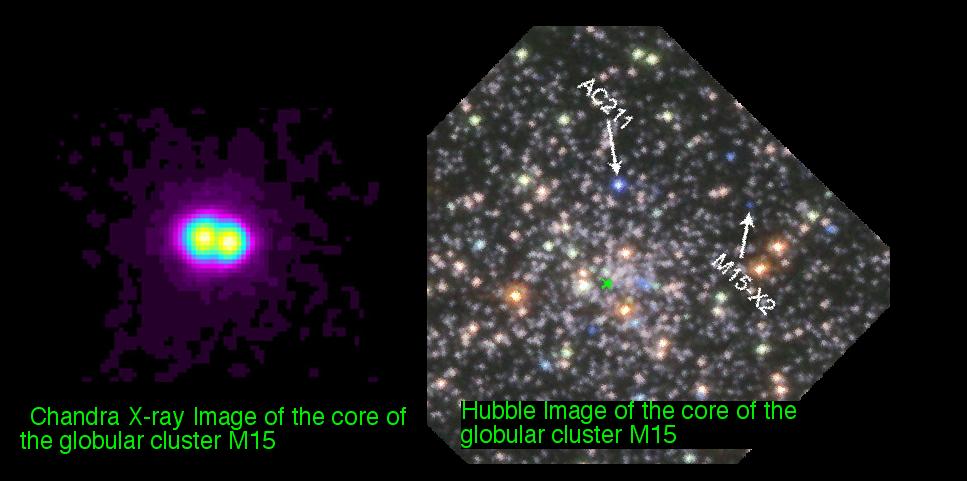
 Credit: Chandra: NASA/GSFC/N.White, L.Angelini; HST: NASA/HST -- P. Guhathakurta
(UCO/Lick Observatory, UC Santa Cruz), B. Yanny (Fermi National Accelerator Lab),
D. Schneider (Pennsylvania State Univ.), J. Bahcall (Inst. for Advanced Study
Credit: Chandra: NASA/GSFC/N.White, L.Angelini; HST: NASA/HST -- P. Guhathakurta
(UCO/Lick Observatory, UC Santa Cruz), B. Yanny (Fermi National Accelerator Lab),
D. Schneider (Pennsylvania State Univ.), J. Bahcall (Inst. for Advanced Study
Resolving Globular Neutron Stars
Globular clusters are balls of hundreds of thousands or millions of ancient
stars; they represent regions of the highest stellar density in our galaxy.
One particularly interesting question is how many of the stars in globulars
have evolved into ultradense neutron stars. But because of the high
concentration of stars, answering such questions has been a real challenge,
somewhat like finding a needle in an astronomical-sized haystack. But
astronomers are rapidly making progress thanks to high spatial resolution
cameras on the Chandra X-ray
observatory, and thanks to the excellent imaging provided by the Hubble Space Telescope in the optical. The
images above show 2 views of the globular cluster
M15. As can be seen in the image on the right, Hubble sees
literally thousands of stars in the cluster; trying to identify the
neutron stars in the cluster from Hubble images would take years or
decades. But the X-ray cameras on Chandra show that the cluster is
only composed of 2 X-ray bright stars, readily identifying two neutron
stars in the cluster. The exquisite images produced by Chandra allow
astronomers to pinpoint the location of the two neutron stars, enabling
them to pick out these two neutron stars from among the thousands that
Hubble sees. The Chandra observation also doubles the number of neutron
stars in M15- earlier X-ray observations could not resolve the 2 neutron
stars from each other, causing astronomers to mistakenly believe that there
was only one neutron star in M15.
Last Week *
HEA Dictionary * Archive
* Search HEAPOW
* Education
Each week the HEASARC
brings you new, exciting and beautiful images from X-ray and Gamma ray
astronomy. Check back each week and be sure to check out the HEAPOW archive!
Page Author: Dr. Michael F.
Corcoran
Last modified December 10, 2001


